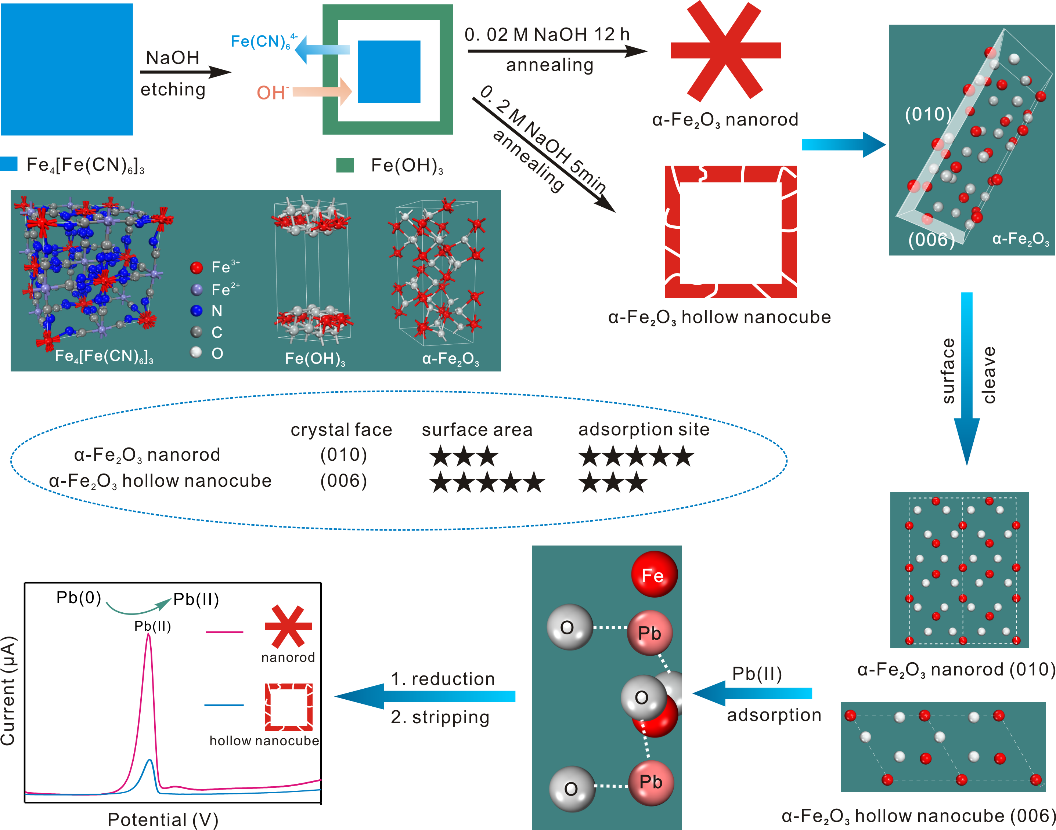In a paper published in Electrochimica Acta, the study team jointly led by Prof. HUANG Xingjiu from Institute of Intelligent Machines, Hefei Institutes of Physical Science revealed the electrochemical analysis mechanism on different performance for the electroanalysis of Pb(II) on Fe2O3 nanorods and hollow nanocubes through the analysis of adsorption sites.
Both the surface areas and the exposure of adsorption sites of nanomaterials can affect the adsorption of heavy metal ions, and then lead to a diverse electrochemical detection response. However, it is an uncoverd mystery that which one is the key factor for detection.
Here, Fe2O3 hollow nanocubes with larger surface areas and Fe2O3 nanorods with more active adsorption sites were successfully synthesized and derived from Prussian blue. The Fe2O3 with two different morphologies were applied to modified bare electrodes that could serve as sensing interface for the electrochemical analysis of Pb(II).
The sensitive detection Pb(II) in near neutral condition was achieved on Fe2O3 nanorods modified GCE with an outstanding sensitivity (109.67 μA μM-1) and a low LOD (0.0034μM). The electrochemical response on Fe2O3 nanorods GCE was much better than the hollow nanocubes with a sensitivity of 17.68 μA μM-1 and LOD of 0.083 μM.
The underlying mechanism of the difference in electrochemical behavior of these two materials was further investigated, which was mainly due to their difference in adsorption sites.
The Fe2O3 nanorods with (010) plane exposed more adsorption sites (Fe-O) on its crystal surface, and would lead to a higher response to Pb(II). The result of the BET suggested that the hollow nanocubes had a larger surface area than nanorods. However, the date of XPS confirmed that the nanorods displayed a better adsorption capacity toward Pb(II). It means that the adsorption sites on the surface of nanomaterials are more dominant than the surface area in electroanalysis.
This finding has a guiding significance for the development of nanomaterials that possess large surface area and especially the exposure of more adsorption sites for the analysis of HMIs.
Link to the paper: Insights into diverse performance for the electroanalysis of Pb(II) on Fe2O3nanorods and hollow nanocubes: Toward analysis of adsorption sites

The strategy for synthesizing diverse morphologies (nanorods and hollow nanocubes) α-Fe2O3 and their different electrochemical response toward Pb(II). (Imaged by LI Shanshan)
Contact:
ZHOU Shu
Hefei Institutes of Physical Science (http://english.hf.cas.cn/)
Email: zhous@hfcas.ac.cn
 Tel: +86-551-65591206
Tel: +86-551-65591206
 Fax: +86-551-65591270
Fax: +86-551-65591270
 Emai: zhous@hfcas.ac.cn
Emai: zhous@hfcas.ac.cn
 350 Shushanhu Road
350 Shushanhu Road